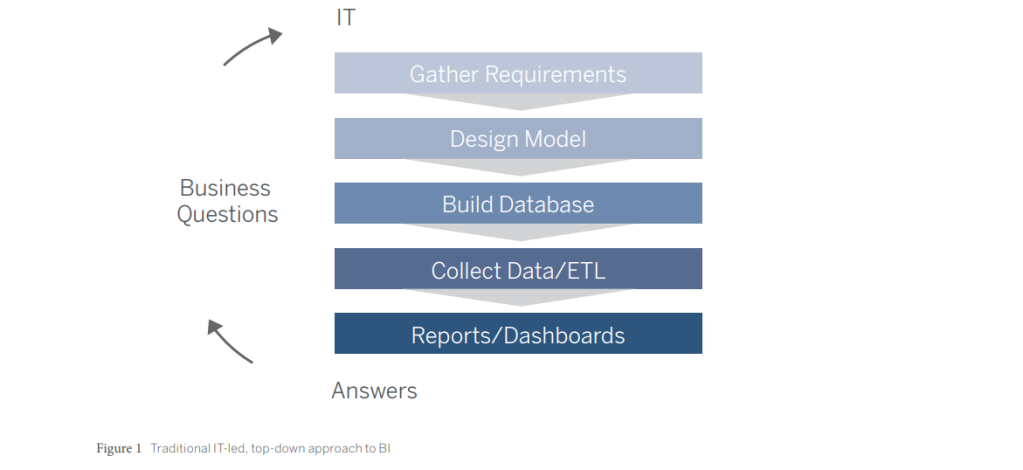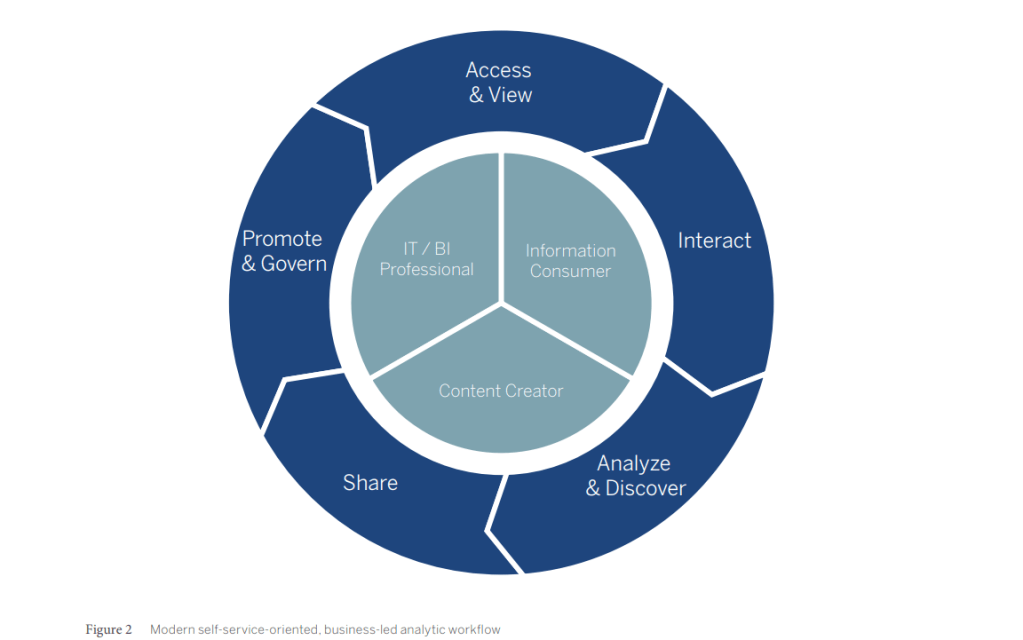Introduction
The primary objective of business intelligence has been the creation of a top-down single source of truth from which organizations would centrally track performance metrics with static reports and dashboards. As a result of this new mandate, IT departments began to approach the problem in the same way as traditional IT projects, where the business makes a request of IT, IT logs a ticket, then fulfill the request following a waterfall methodology.There was a significant lag between when the question was asked and when it was answered.Adoption and business impact were low due to the delay and lack of agility within the analysis process.
IT is at a crossroad with self-service BI as the new normal that can no longer be ignored. As the business demands the agility that comes with self-service to drive adoption and improve organization outcomes, the traditional approach to BI is becoming less relevant. IT has an important choice due to the continued growth in data volume and complexity.
A new framework and overall strategy is required as organizations transition from a top-down approach driven by IT to a self-service approach enabled by IT and led by the business. The core components of a business intelligence program must be reexamined. In order to support the shift from a model of top-down BI development and delivery to a self-service-based modern BI model, adjustments are needed in these three core areas.
People
A successful transition to self-service business analytics starts with people and should be the top priority for IT. People were considered last after the platform and process. The slogan “if you build it, they will come” exemplifies the belief that business users would gravitate towards a well-built system of record for BI that would answer all of their business questions.The desired end-state rarely came to fruition since there was little to no collaboration between the business users and IT during the process of building the solution after an upfront requirements-gathering phase. There are many opportunities for failure in the absence of feedback from the business during the time between requirements gathering and project completion. A few of the most common include:
- Incomplete or inaccurate requirements are given in the initial process phases.
Business requirements are not gathered and not translated into technical requirements correctly. - The initial requirements are rendered obsolete or invalid by business or organizational changes during the development process.
Business users disengage from the program completely and an organization’s investment in time and resources is wasted due to lack of adoption. Business users and analysts need to use analytic tools in order to deliver value.
Collaboration between the business and IT is critical to the success of the implementation as IT knows how to manage data and the business knows how to interpret and use data within the business processes they support. They have the context within which analytics and the insight derived from it will be used to make better business decisions and ultimately improve outcomes. This collaboration of the groups early on will not only lead to the deployment of a platform that meets the needs of the business but also drives adoption and impact of the platform overall.A business intelligence model that embraces self-service puts these users first and allows them to explore, discover, and build content that they will ultimately use to make better business decisions and transform business processes.
Process
End users are not allowed unfettered access to any and all data and analytic content. They have the freedom to explore data that is trusted, secure, and governed. The component that requires the most significant shift in traditional thinking for IT is represented by process. A successful modern BI program can deliver both IT control and end-user autonomy. A well-established and well-communicated process is needed for an organization to strike this delicate balance.
A waterfall-based process only addresses the IT control part of the equation. A traditional deployment focuses on locking down data and content. It means limiting access and freedom to only a few people with specialized technical skills who are expected to meet the needs and answer the questions of the many. This typically involves developer-centered processes to design and build the enterprise data warehouse model, build the ETL jobs to transform and load data into the model, construct the semantic layer to mask the complexity of the underlying data structures, and finally build the business facing reports and dashboards.
This approach often fails to deliver on the vision and promise of BI, to deliver significant and tangible value to the organization through improved decision making with minimal time, effort, and cost. IT-led BI models have an inverse profile of time, effort, and cost compared to the value they deliver to the organization.

Tableau
New processes and roles are needed to enable a collaborative self-service-based development process. IT and users need to work together to develop the rules of the road for their secure environment in order to maximize the business value of analytics without compromising on the governance or security of the data.
Merely supplying data and content to users without any regard for whether or not it is adopted and provides value through improved outcomes is simply not enough. Modern BI requires updated processes to support self-service analytics across the organization. It also requires the definition of new success metrics for which IT and the business are jointly accountable and are therefore equally invested.
The value of IT to the organization is highlighted when the business can realize significant value and benefit from investments. Should IT still be considered successful even if no one uses the system to influence a single decision? There are too many metrics that are not tied to outcomes or impact in traditional processes. Many IT organizations would consider themselves successful if the ETL jobs that it created ran without failure and the EDW was loaded without error.
Where processes and technology intertwine, there is tremendous opportunity. Technical innovations, especially with AI, will continue to make it easier to automate processes and augment users of all skill levels throughout the analytics workflow. And while process can accelerate, rather than inhibit, successful analytics outcomes, it’s important to recognize that this relies on a system and interface that people are eager to use. If processes aren’t supported by the right platform choice, they will stifle adoption.
BI
Since BI has been historically viewed as an IT initiative, it is not surprising that IT drove virtually every aspect of platform evaluation, selection, purchasing, implementation, deployment, development, and administration. But with drastic changes required to modernize the people and process components of a BI and analytics program, IT must change the criteria for choosing the technology to meet these evolving requirements. Perhaps the most obvious change is that IT must intimately involve business users and analysts from across the organization in evaluating and ultimately deciding which modern platform best fits the organization and addresses the broad needs of the users. For more information on selecting the right analytics platform, check out the Evaluation Guide.
A modern platform must address a wide range of needs and different personas as well as the increased pace of business and the exponential growth in data volume and complexity. IT requires that the chosen platform enables governance and security while end users require easy access to content and the ability to explore and discovery in a safe environment.
The chosen platform must also be able to evolve with the landscape and integrate easily with other systems within an organization. A centralized EDW containing all data needed for analysis, which was the cornerstone of traditional BI, is simply not possible in the big-data era. Organizations need a platform that can adapt to an evolving data landscape and insulate users from increased complexity and change.
The most critical aspect is the ability to meet these diverse needs in an integrated and intuitive way. This integration is depicted on the following page as the modern analytic workflow. The diagram highlights the five key capabilities that must flow seamlessly in order for the three personas depicted in the center to effectively leverage the platform.

The BI and analytics platform landscape has passed a tipping point, as the market for modern products is experiencing healthy growth while the traditional segment of the market is declining with little to no net new investment. IT leaders should capitalize on this market shift and seize the opportunity to redefine their role in BI and analytics as a far more strategic one that is critical to the future success of the organization. Adopting a collaborative approach to recast the foundational aspects of the BI program and truly support self-service is the key to changing the perception of IT from a producer to a strategic partner and enabler for the organization.
Promise
In today’s era of digital transformation, IT leaders are increasingly expected to take on digital business initiatives in their organizations, including identifying cost savings and finding new revenue streams. Realizing the value of data for these transformational efforts, many businesses are modernizing and increasing their analytics investments to innovate and accelerate change. Everyone agrees that putting data at the center of conversations promises change. However, most organizations are failing to successfully implement an enterprise-wide analytics program.IT is well positioned for a leadership role in these efforts, and is essential for the task of giving people the relevant data they need for decision-making. Modern analytics shifts IT’s role to a more strategic partner for the business, empowering users to navigate a trusted, self-service environment. But beyond access to the data, everyone needs the motivation and confidence to properly make decisions with it. You need to identify the relationships between job functions and data and change behaviors that run deep into the fabric of your organization’s culture.
This also means expanding your definition of self-service so that business users participate in some of the traditionally IT-led responsibilities associated with data and analytics—like administration, governance, and education. With the right processes, standards, and change management, business users can help manage data sources, analytics content, and users in the system, as well as contribute to training, evangelism, and the internal community. When users value and participate in these efforts, IT can manage strategic initiatives like business SLAs and ensuring the security of company assets.
Although every organization’s journey to building a data-driven organization will differ, achieving your transformational goals requires a deliberate and holistic approach to developing your analytics practice. Success at scale relies on a systematic, agile approach to identify key sources of data, how data is selected, managed, distributed, consumed, and secured, and how users are educated and engaged. The better you understand your organization’s requirements, the better you will be able to proactively support the broad use of data.
Tableau Blueprint provides concrete plans, recommendations, and guidelines as a step-by-step guide to creating a data-driven organization with modern analytics. We worked with thousands of customers and analytics experts to capture best practices that help turn repeatable processes into core capabilities to build and reinforce a data-driven mindset throughout your organization. Learn more and get started today.

